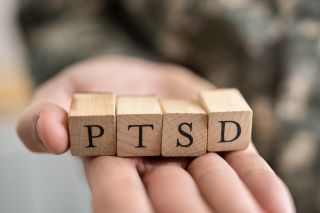Anger is often a normal response to the intense threat associated with trauma. Anger puts your body into a “survival” mode and activates your energy to protect yourself or others. However, for some, the experience of a shocking, threatening, or dangerous event can lead to post-traumatic stress disorder (PTSD). It is a shock to the body’s system of regulation that leads to fear during and following the traumatic event. The body’s “fight, flight or freeze” response, which helps us avoid or respond to potential anger, may lead to heightened arousal that becomes the normal state, leading to emotional and physical feelings of anger that are more intense. As such, you may feel stressed or frightened even when no real danger exists. Some people recover from the initial symptoms over time, while others continue to experience symptoms of arousal contributing to the diagnosis of PTSD.
PTSD may be experienced by combat veterans and those who have experienced or witnessed a physical or sexual assault, abuse, an accident, a disaster, or other similar events. PTSD may arise at any age.
A diagnosis of PTSD requires that an individual experience certain symptoms including arousal and reactivity for at least one month. This entails being quick to startle, feeling tense, on guard or on edge, feeling irritable, and having angry or aggressive outbursts.

Alphabet blocks showing PTSD.
Source: Andriy Popov/Alamy Stock Photo
PTSD and anger
Both forms of trauma may yield anger, but years of research indicate that anger is especially associated with PTSD. Yet, this same research finds that anger may not always lead to aggression. Numerous studies have been made to clarify factors that contribute to anger for those with PTSD.
One study of 742 participants, some in the service and others who were ex-serving members, found that the majority had significant anger problems at intake for a treatment program for PTSD (Cowlishaw, Metcalf, Little, et. al., 2021).
A meta-analysis covering 39 studies found that anger and hostility were highly associated with PTSD (Orth & Wieland, 2006). This study also found that those who had experienced combat were more highly prone to anger and hostility. The researchers discussed the possibility that those selected for combat may have had more trait anger, assertiveness, and aggression prior to their service.
Another meta-analysis focused on determining the extent to which anger is specific to PTSD rather than anxiety disorders in general (Olatunji, Giesielski & Tolin, 2010). It found that those with anxiety disorders had significantly greater difficulties with anger. However, it also found that, even when compared to this group, those with PTSD had significantly greater difficulties with anger. Additionally, difficulty with anger control, directed inward or outward, also differentiated those with PTSD from those with non-PTSD anxiety disorders.
The association between PTSD and anger and aggression appears stronger for men than women (Taft, Creech & Murphy, 2017). It is suggested that this reflects differences in internalizing versus externalizing responses to trauma.
Another study found that those with higher scores in meta-cognition (awareness and understanding of one’s thoughts derived from self-reflection) were associated with lower levels of state anger (situational arousal), feeling angry, physically expressing anger, and self-directed anger (Leonhardt, Lysaker, Vohs, et. al., 2018). Additionally, it found that higher levels of depression were related to higher levels of trait anger (ongoing predisposition to anger), expressing anger physically, expressing it outward and inward.
A study of over 2,000 soldiers returning from deployment in Iraq and Afghanistan found that anger was highest for those diagnosed with PTSD and major depressive disorder (Gonzalez, Novaca, Reger, et. al., 2016). It concluded that anger assessment should be included as part of post-deployment risk assessment
In teasing out factors contributing to anger and PTSD, one study found that PTSD is not the overall direct contributor to different forms of aggression (Bhardwaj, Angkaw, Franceschetti, et. al., 2019). Specifically, it found that depression symptoms explain the relationship between PTSD and verbal aggression, physical aggression toward objects, and physical aggression toward self. Additionally, it found that trait anger explains part of the relationships between PTSD and verbal aggression, physical aggression toward objects, and physical aggression toward others.
A huge study, including 12,806 military personnel and veterans, found that PTSD was the strongest risk factor for problem anger (Varker, Cowlishaw, Bauer, et. al., 2022). Such anger was also found to correlate with suicidal attempts and violence. Additionally, such anger is also associated with non-suicidal self-injury in veterans.
A systematic review of 47 studies found a strong association between shame and PTSD (Saraiya & Lopez-Castro, 2016). As such, it concluded that shame should be recognized and addressed in the treatment of PTSD.
Impulsivity may be a factor contributing to anger expression by those with PTSD (Contractor, Armour, Wang, et. al., 2015). However, such impulsivity may also be a way of coping with the distress of anger.
Studies that look at the impact of different experiences leading to a diagnosis of PTSD further our knowledge of what may be essential for effective treatment. For example, one study found that PTSD related to the traumatic loss of a loved one was more highly associated with the desire for revenge as well as anger at the self (Lenferink, Nickerson, Kashyap, et. al., 2024). It identified five different types of anger, directed at: 1) the criminal justice system, 2) other people, 3) the self, 4) the perpetrator and a desire for revenge. Anger at the self and perpetrators was dominant for those diagnosed with PTSD. Anger at the self was also most strongly associated with prolonged grief.
Treatment
Accurate treatment of PTSD calls for a thorough and comprehensive assessment to determine those specific factors that may be most prominent for any individual with this diagnosis.
A systematic review explored the impact of treatments targeting anger symptoms in veteran and military populations with PTSD (Metcalf, Finlayson, Forbes, et. al. 2023). It found that anger-focused treatments that were trauma-informed held more promise.
Scott Miller provided a summary of treatment approaches used over the last 20 years to treat anger in military veterans (Miller, 2019). Cognitive behavioral therapy had become the primary approach, entailing 12 group sessions combining a didactic and an experiential component. It also reported that while these are effective in the short term, a psychodynamic approach was found to yield long-lasting improvement.
Emotional-focused therapy for trauma offers another approach for dealing with trauma (Paivio & Pascual-Leone, 2023). A major component of this approach emphasizes some focus on working through feelings regarding interpersonal issues that surround early mistreatment. This phase involves the “full experience and expression of previously inhibited adaptive anger at maltreatment and sadness related to loss, which lead to meaning exploration and change.”
A pilot study involving 16 veterans with PTSD showed favorable results with compassion-focused therapy (Clark, Kolts, Lovejoy, et. al., 2019). The treatment decreased anger symptoms, PTSD symptoms, and fears of compassion.
The diagnosis of PTSD may be used to describe reactions to a broad range of trauma. Yet, it is highly associated with an increased tendency toward anger arousal. Effective treatment of PTSD requires a comprehensive assessment that determines an individual unique constellation of symptoms including an understanding of the nature of anger associated with it. The good news is that an accurate assessment can lead to a more highly effective treatment program that addresses the unique needs of the individual.
To find a therapist, please visit the Psychology Today Therapy Directory.
